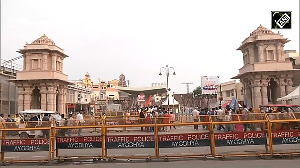Firozabad's glass house lies shattered. Just a few years ago, the glass products industry in this tinsel town, 40 km from Agra in Uttar Pradesh, was bustling.
An estimated 480 small scale manufacturing units were in operation, producing glass beads, bulbs, vases, light globes, chandeliers, tableware, bangles and other handcrafted items.
Domestic sales were up and the local manufacturers had their hands full with export orders. The fires in the pot and tank-type furnaces in the glass waste-strewn city seemed never to go out, and the chimneys billowing smoke in the sky confirmed that the town was in business.
Cut to 2007. The fire in a little over 300 glass units has ebbed out. The mud furnaces have crumbled from disuse and the topography resembles a wasteland. Thousands of labourers are jobless as their employers have gone bankrupt.
Glass industry estimates suggest that exports have crashed by 50 per cent and the domestic market has dwindled alarmingly. The manufacturers, once-proud owners of large units, look dispirited as they search for alternative means to generate revenue. The city that used to be dotted with skeins of coloured glass has lost its sheen.
Meet Lokesh Agarwal. He sits forlorn in his hole-in-the-wall office at the edge of his vast premises. He would operate what is called the Japanese pot furnace unit (the other two being the open furnace and the tank furnace) and employed 250 people as daily labour. The unit produced lights, tableware and lanterns for the domestic and the export markets.
"We used to make 350,000 glass shells for bulbs every day. My turnover was Rs 2.5 crore a year. That business is over," says a despondent Agarwal. His pot furnace unit now lies in ruins.
So what does he do for a living? Here's the irony. He's now importing bulb shells and glass products from China - the country which has brought Firozabad's centuries old cottage industry to the brink of closure - and selling them in Delhi and other markets in Uttar Pradesh.
To be sure, while the industry was not exactly problem-free before the Chinese invasion, the entry of cheap glass products from the land of the dragon has dealt a death blow to the glass makers of Firozabad.
Cheap Chinese glass products - shells required for making electric bulbs, vases, tableware, glass tumblers and other home accessories - have flooded Indian markets. And they've been an instant hit as they are 40-50 per cent cheaper than similar wares from Firozabad's factories.
"The Chinese products have overtaken our markets and eroded our profitability," admits V D Singh, managing partner, Electronic Glass Industries.
Singh runs a tank furnace unit that once made a range of products. His company exported glass lanterns to Africa among other countries. Today the Chinese lord over the lantern market.
Consequently, 45 of the 50 mid-level pot furnace glass units in Firozabad have been wiped out. Says Lokesh Agarwal: "Howsoever hard we may try, we cannot match China's prices. Look at this," he points to a large flower pot in red glass, "it costs me Rs 45 to produce this. In China, a similar product costs Rs 20 to make."
His friend Shailendra Paliwal's business has also taken a hit. A huge inventory of glass rods is piling up in his godowns. These glass rods are chipped to make pieces for decorating fancy glassware. "Even glass beads used on garments, which were a Firozabad speciality, are now coming from China," rues Paliwal.
In the absence of any authentic data on Firozabad's glass business, one has to believe what the industry veterans spout. They, for instance, insist that of the roughly 160 units that are in business, 80-90 per cent are dependent on the traditional glass business - bangles - for survival.
"Only the remaining 10 are still making other handicrafts," says Paliwal. As a survival strategy, even his factory is churning out bangles, a product category where China is yet to step in.
Surprisingly, Paliwal is not the only one who has turned to making bangles. V D Singh, who is also president of the Industrial Estate Association (Firozabad), has converted one of his furnaces to make bangles.
And why not, the city, after all, produces Rs 1 crore (Rs 10 million) worth of bangles every day. Devi Charan Agarwal, one of the biggest glass producers in Firozabad, says: "Bangles, in fact, is a growing market."
Agarwal, whose export turnover was Rs 10 crore (Rs 100 million) a year, has seen his fortunes dip by 40 per cent in the last couple of years. "Yes, China has affected our export market too," he says.
Glass exports from the city have plunged from Rs 200 crore (Rs 2 billion) to about Rs 100 crore (Rs 1 billion). But Devi Charan Agarwal does not blame China alone for the state of affairs in Firozabad. "The decline started much earlier and there are other reasons for it," he says.
The trouble began in the late '90s when a Supreme Court order banned all industries from using either coke or coal within the Taj Trapezium Zone. And thanks to its proximity to Agra, Firozabad fell well within the stipulated area.
The industrial estate's president Singh puts things in perspective: "We had no experience of working on gas-based furnaces and the government certainly did not help us in making the conversion."
For starters, not everybody applied for the natural gas that was being supplied by the Gas Authority of India Limited. "And those who did, did not even know how much gas they would need to run their units," points out Singh. Besides, they had nowhere to go to figure out how to re-design their traditional furnaces to suit the new fuel.
Eventually, the gas reached only 50 per cent of the glass makers in the city. "Ideally, since competition was halved overnight, the remaining players should have made pots of money. But that's not been the case," says Singh, "we are also dying."
Here is why. For starters, there's been a shortage of gas ever since GAIL started supplying it. The city gets 900,000 cubic metre of gas per day instead of the 11 lakh (1.1 million) that was promised.
In fact, the larger players got their quota on a first-come, first-served basis while the remaining gas was evenly distributed among the mid-sized players. "In most cases the allocation is not sufficient to fuel the furnaces," says Paliwal.
Secondly, the Firozabad glass industry has never been cost-competitive. Both fuel and raw material costs are high - at 35 per cent each of the total cost of operations, the remaining being the labour cost. Gas, the glass makers claim, is very expensive. Though it is subsidised, their argument is that it should be delivered to them at a cheaper rate.
"If Gujarat can supply it at a lower rate, why are we paying a higher price?" asks Singh. In Firozabad, gas costs Rs 6,500 per 1,000 cubic metre compared to Rs 3,600 per cubic metre in Gujarat. That's not all. "If we exceed our fixed quota of gas (which comes through the pipeline and is measured by the metre), we are charged for it at a whopping Rs 23 per cubic metre," says Paliwal.
Soda ash does not come cheap either. In India, soda ash prices have escalated from Rs 8,000 per tonne a couple of years ago to Rs 13,000 a tonne today. In China, soda ash costs Rs 4,500 a tonne. Glass industry representatives claim that only a handful of companies such as Tata, Birla and Gujarat Heavy Chemicals make soda ash. "They form a cartel and raise prices at whim," says Singh.
Last, but not least, the industry is reeling under heavy taxation. Or so it claims. Devicharan Agarwal says that sales tax and excise duties are at 16 per cent each. "My point is that China manages to reach its stuff to Mumbai at the same rate as we do."
So what are the options before the glass makers of Firozabad? To start importing products from China, is one. Of course, not everybody wants to be a trader.
"We are manufacturers and want to remain so," says Mohanlal Agarwal, honorary secretary, UP Glass Manufacturers Syndicate, who makes bangles and other handicrafts at his unit, adding that he's discounting heavily to remain in the business. "I am busy trying to save this unit from closing down," Singh says.
The other option is to switch to completely mechanised plants. Singh, for instance, has put up an automated plant to make glass shells for bulbs which he is supplying to major brands like Bajaj, Osram and the like.
Earlier, he employed 150 people; today he needs only 25 workers. Though Singh admits that Firozabad's glass industry needs to reinvent itself to survive, he points out that its biggest failure has been that it has not been able to lobby its case properly before the government.
The third option, and many are resorting to it, is that the manufacturers forge alliances to cut costs and use their facilities better.
Whatever its weaknesses, Chandwar Nagar, as it was called before being renamed Firozabad during Akbar's reign, needs urgent resuscitation if its traditional glass factories are to survive. Else the entire town will be decked in glass accessories from China.
The Mughals may no longer be around to order jhadfanus or chandeliers for their courts, as they did in the 16th century, but for those who have succeeded them to power in India, the lights they order for their homes and offices these days will probably bear the stamp: Made in China.
But Moradabad says Firozabad can survive by following its example
One of Moradabad's largest handicrafts export houses, the Rs 120-crore (Rs 1.2 billion) CL Gupta Exports Limited services major international clients such as Wal Mart, Ikea, Target and William Senoma, among others.
The company supplies furniture and home accessories in metal, wood and glass to these retail chains. Not quite happy with the quality of glass available in Firozabad, Raghav Gupta, managing director of the export house, set up his own glass unit on the outskirts of Moradabad. "Firozabad produces very low quality glass. The manufacturers use poor quality raw material," he says.
At the inhouse factory, Gupta uses the European method to melt glass. "Firozabad employs outdated methods to blow and melt the glass," he points out. Unlike Gupta, Vinay Goyal is a much smaller Moradabad exporter who sources unfinished glass from Firozabad for his mixed metal and glass wares.
"I agree that Firozabad produces second grade glass," says Goyal. "It is not sparkling clear and has bubbles." He has found a way out, though. "We do a lot of sorting when we source glass. For instance, if I need 100 pieces, I buy 160." Firozabad's baking method is also old, he adds.
China is beating Firozabad hollow on prices as its products are machine-made while Firozabad's glass industry is very labour intensive and adds to the cost.
"The city's glass industry is suffering because it did not have the marketing skills to promote itself. It enjoyed a monopoly for years but it could not leverage that advantage when competition came knocking," points out Gupta.
Goyal is softer on the industry. "I am sure they can compete on quality, except that their prices would go up. Currently, the price wars are killing them."
Clearly, the ancient town failed to change its ways. However, even today, investments in automatic machines and scaling up volumes could prop up their bottomlines.







 © 2025
© 2025